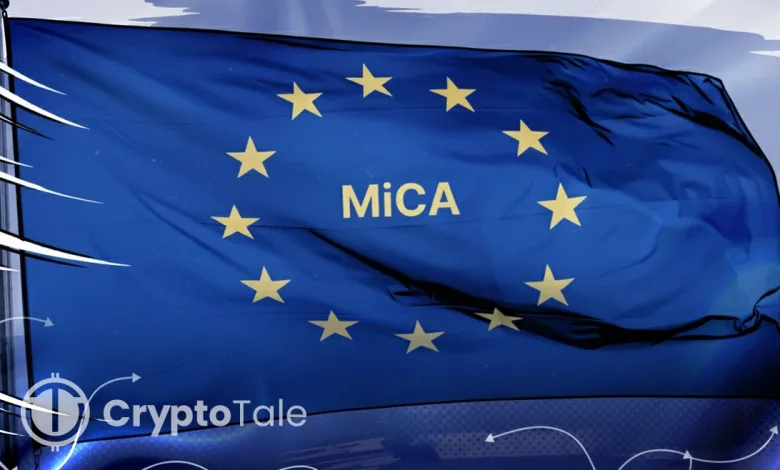How MiCA 2025 Changes Crypto Rules Across the European Union

The Markets in Crypto-Assets Regulation (MiCA) is the EU’s first comprehensive set of rules specifically regulating crypto-assets that are not covered by existing financial laws. It establishes uniform standards for issuers and crypto-asset service providers (CASPs) throughout all 27 EU member states. The regulation came into force on December 30, 2024, while stablecoin regulations have been effective since June 30, 2024. MiCA’s goal is to safeguard consumers, uphold market integrity, and facilitate cross-border transactions with a single authorization system
The rules have also been clarified and tightened by EU supervisors through 2025. As of October 6, 2025, ESMA has an interim public register of authorized CASPs and notified white papers. The EBA has released crypto risks AML/CFT guidance. These measures, combined, signify the transition of MiCA from legislation to day-to-day supervision.
MiCA’s Scope and Purpose
MiCA covers crypto-assets that are not already regulated as traditional securities or funds. It establishes a taxonomy that matters for compliance and investor rights. Issuers of asset-referenced tokens (ARTs) and e-money tokens (EMTs)—the regulation’s two stablecoin classes—face reserve, redemption, and governance obligations. MiCA also sets disclosure, white-paper, and conduct rules for other crypto-assets admitted to EU trading platforms.
The regulation’s purpose is two-fold. It provides investors with clear information and legal safeguards, offering firms the certainty of law for cross-border operations. These aims align with the EU’s Digital Finance Strategy. The Commission notes that the “legal obligation to comply” began for stablecoins in June 2024 and for the wider CASP regime in December 2024.
Timeline and Transition
Two application dates define the rollout. Stablecoin provisions commenced on June 30, 2024, and the broader CASP framework took effect on December 30, 2024. ESMA and national competent authorities signaled these milestones well in advance to encourage firms to prepare.
MiCA also contains a transition regime. Firms that lawfully provided crypto-asset services under national law before December 30, 2024, can continue until July 1, 2026, or until their MiCA authorization is granted or refused. ESMA highlights a simplified authorization route for some pre-authorized firms. During the transition, grandfathered entities cannot passport across the EU.
Stablecoin Rules Under MiCA: ARTs, EMTs, And “sell-only” Windows
Stablecoin issuers face the heaviest scrutiny. ARTs reference baskets of assets, while EMTs reference a single fiat currency. Issuers must maintain reserves, honor redemption rights, and meet governance standards. Significant tokens face direct EBA oversight. The legal text sets these duties and allocates supervisory roles among ESMA, EBA, and national authorities.
In January 2025, ESMA urged firms to restrict non-MiCA-compliant stablecoins and allowed a limited “sell-only” period, enabling EU users to exit their positions. The statement clarified which activities constitute public offerings or admissions to trading for ARTs/EMTs and established expectations for CASP behavior while issuers seek compliance.
Exchanges adjusted quickly. Major venues are expected to announce or complete delistings of non-compliant stablecoins by the end of Q1 2025 for EEA users, consistent with ESMA’s timeline. Binance set a March 31, 2025, deadline for removing non-compliant stablecoin pairs; Kraken’s support page now lists the tokens that have been delisted in the EEA.
Related: Kraken Secures MiCA License to Expand Crypto Services in EU
CASP licensing, passporting, and conduct standards
MiCA provides a single authorization, which, after being granted, allows passporting throughout the Union. The authorization and passport regime in the EU, as described by the EBA in October 2025, lists the supervisory requirements in governance, fitness and propriety, and beneficial ownership transparency. In the transition to July 2026, grandfathered firms are unable to pass their passports.
CASPs must adhere to rules governing organization, record-keeping, conflicts of interest, complaint handling, and the safeguarding of client assets. ESMA and the Commission have already finalized several Level 2 measures that specify these obligations, such as templates for authorization filings, order-book data standards, and transparency formats. These measures now take effect according to their publication dates in the Official Journal.
Since 2023, the Commission and ESMA/EBA have adopted delegated regulations that implement technical standards and guidelines to “fill in” MiCA. The most relevant for firms in 2025 include:
- Inside-information disclosure (MiCA Title VI): Implementing Regulation (EU) 2024/2861 sets technical means for public disclosure and permitted delays.
- Authorization templates for CASPs: Implementing Regulation (EU) 2025/306 standardizes application forms and procedures.
- Order-book records and transparency data: Delegated Regulations (EU) 2025/416 and 2025/417 set content, format, and disaggregation requirements.
- Continuity and record-keeping for services: Delegated Regulation (EU) 2025/299 specifies resilience measures, while Delegated Regulation (EU) 2025/1140 adds detail on record-keeping.
- Complaints and conflicts of interest: Delegated Regulations (EU) 2025/294 and 2025/1142 set procedures and minimum standards.
- White-paper data and machine-readability: Delegated Regulation (EU) 2025/421 defines required data fields.
These measures are in addition to sustainability-related disclosures for issuers and platforms, as highlighted in legal briefings, which will be applicable from June 2024 for certain activities.
Decisions shaping enforcement: restrictions, marketing, and payments perimeter
Supervisors have identified two near-term risks: non-compliant stablecoins and confusing marketing that combines regulated and unregulated services. In January 2025, ESMA requested that NCAs and firms transition non-compliant ARTs/EMTs to “sell-only” status while issuers seek authorization. ESMA’s statement emphasized that offering or admitting such tokens to trading triggers MiCA obligations even if a third party—not the issuer—initiates the activity.
In July 2025, ESMA warned that CASPs must not use a MiCA license to imply that all products on their platforms are protected under MiCA. “The practice of CASPs offering both MiCA-regulated and unregulated products and services gives rise to investor protection risks,” the authority said.
Supervisors also clarified the payment perimeter for EMTs. On June 10, 2025, the EBA issued an opinion on the interplay between MiCA and PSD2/EMD. It allows NCAs, on a case-by-case basis, to grant a transition period to 1 March 2026 for firms that need payment services authorization to continue certain EMT-related activities.
Licensing Momentum
Licensing has started to scale. ESMA’s interim MiCA register provides centralized visibility of authorized CASPs, notified white papers, and significant token decisions, with regular updates through October 2025. This improves transparency for customers and counterparties.
The stablecoin mix in Europe has shifted. As exchanges restricted non-compliant tokens by March 2025, MiCA-compliant issuers moved to meet demand. Circle announced MiCA compliance and an EMI license in France in July 2024, enabling EU issuance of USDC and EURC. Société Générale-Forge continued to scale EURCV and introduced a USD-pegged EMT (USDCV) for institutional clients during 2025. These steps illustrate how regulated fiat-linked tokens are gaining traction under MiCA.
Banks and large financial firms have begun testing tokenization and stablecoin rails within the EU perimeter. Nine European Banks announced in October 2025 that they plan to launch a MiCA-compliant stablecoin in 2026, following authorization in Spain, highlighting mainstream interest.
Supervisory centralization has re-entered the policy debate. ESMA’s chair said that the Commission is preparing reforms to expand ESMA’s direct powers, citing the need for a more unified approach to MiCA supervision. Reuters also reported that member states remain divided, with some favoring national control. These discussions may affect how MiCA supervision evolves in 2026 and beyond.
Related: Nine European Banks Unite to Launch MiCA Euro Stablecoin by 2026
Market integrity and AML: new tools and sharper expectations
MiCA extends a market-abuse regime tailored to crypto-assets admitted to EU platforms. ESMA finalized guidelines in 2025 to align supervisory practices and support surveillance against insider dealing and manipulation. The Implementing Regulation on inside-information disclosure sets technical means for public dissemination and permissible delays. Firms must adjust systems and controls accordingly.
AML/CFT supervision has tightened around crypto-asset businesses. In October 2025, the EBA published lessons from recent cases. The report calls out reverse-solicitation risks, forum shopping, and complex group structures that obscure beneficial ownership. It explains how MiCA’s authorization, governance, and passporting tools should reduce arbitrage if NCAs apply them consistently.
What MiCA Means in Practice for 2025–2026
For stablecoin issuers, the practical steps are clear: obtain authorization, align reserves and redemption processes, prepare recovery plans if applicable, and comply with disclosure and insider information rules. Issuers of significant tokens should expect direct scrutiny from the EBA.
For CASPs, priorities include completing authorization filings, upgrading surveillance and record-keeping systems, clarifying marketing to distinguish between regulated and unregulated products, and preparing for cross-border passporting after authorization. ESMA’s Level 2 measures give the templates, data fields, and operational details.
The Bottom Line
MiCA now shapes crypto activity across a market of more than 450 million people. It supplies standard definitions, predictable authorization, and consistent investor protections. 2025 demonstrated how supervisors intend to enforce the rulebook: restricting non-compliant stablecoins, policing marketing, and standardizing filings and transparency. At the same time, more regulated stablecoin issuance is arriving, including from banks and large payment players.
The coming year will test whether authorization backlogs clear and whether EU institutions opt for more centralized supervision. Regardless of that choice, the direction is clear. The EU now expects crypto businesses to meet the same standards of governance, disclosure, and customer protection as those applied to other financial sectors. As ESMA noted in January, firms could maintain non-compliant tokens only on a “sell-only” basis during the final exit window—an early indication of strict enforcement.





